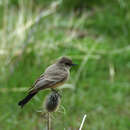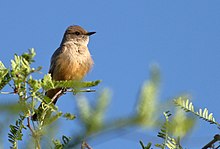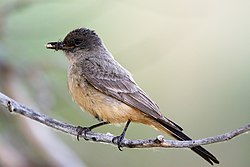zh-TW
在導航的名稱


Sayornis saya ye una especie d'ave paseriforme de la familia Tyrannidae orixinariu d'América del Norte.
Pue atopase mientres tol añu dende l'oeste de Coloráu hasta'l sur de California, y dende l'este de la península occidental de Texas hasta l'oeste de Méxicu. Reproducir dende Alaska, l'oeste y el centru sur de Canadá, traviés de Dakota del Norte, el Mediu Oeste y Nuevu Méxicu. Nel iviernu migra a zones desérticas de Texas al traviés de Méxicu hasta'l norte d'América Central. Mientres la migración d'estes aves pueden atopase a miles de kilómetros fora del so rangu. Estes aves prefieren paisaxes secos, afaraos y grebos. Pueden atopase en montes, tierres de cultivu y sabanes, xeneralmente cerca de l'agua.
 Esta páxina forma parte del wikiproyeutu Aves, un esfuerciu collaborativu col fin d'ameyorar y organizar tolos conteníos rellacionaos con esti tema. Visita la páxina d'alderique del proyeutu pa collaborar y facer entrugues o suxerencies.
Esta páxina forma parte del wikiproyeutu Aves, un esfuerciu collaborativu col fin d'ameyorar y organizar tolos conteníos rellacionaos con esti tema. Visita la páxina d'alderique del proyeutu pa collaborar y facer entrugues o suxerencies. Sayornis saya ye una especie d'ave paseriforme de la familia Tyrannidae orixinariu d'América del Norte.
Aderyn a rhywogaeth o adar yw Ffebi Say (sy'n enw benywaidd; enw lluosog: ffebîau Say) a adnabyddir hefyd gyda'i enw gwyddonol Sayornis saya; yr enw Saesneg arno yw Say's phoebe. Mae'n perthyn i deulu'r Teyrn-wybedogion (Lladin: Tyrannidae) sydd yn urdd y Passeriformes.[1]
Talfyrir yr enw Lladin yn aml yn S. saya, sef enw'r rhywogaeth.[2]
Mae'r ffebi Say yn perthyn i deulu'r Teyrn-wybedogion (Lladin: Tyrannidae). Dyma rai o aelodau eraill y teulu:
Rhestr Wicidata:
rhywogaeth enw tacson delwedd Gwybedog bronwinau’r Gogledd Aphanotriccus capitalis Gwybedog pigddu Aphanotriccus audax Teyrn corunllwyd Attila bolivianus Teyrn cycyllog Attila rufus Teyrn gwinau mawr Attila cinnamomeus Teyrn gylfingam y De Oncostoma olivaceum Teyrn gylfingam y Gogledd Oncostoma cinereigulare Teyrn melyngoch Attila torridus Teyrn tinfelyn Attila spadiceus Teyrn torfelyn Attila citriniventrisAderyn a rhywogaeth o adar yw Ffebi Say (sy'n enw benywaidd; enw lluosog: ffebîau Say) a adnabyddir hefyd gyda'i enw gwyddonol Sayornis saya; yr enw Saesneg arno yw Say's phoebe. Mae'n perthyn i deulu'r Teyrn-wybedogion (Lladin: Tyrannidae) sydd yn urdd y Passeriformes.
Talfyrir yr enw Lladin yn aml yn S. saya, sef enw'r rhywogaeth.
Der Zimtbauch-Phoebetyrann (Sayornis saya) ist ein amerikanischer Schreivogel.
Der 16 cm lange Zimtbauch-Phoebetyrann ist auf der Oberseite braun-grau und am Bauch braun-orange gefärbt. Hals und Brust sind hellgrau. Jungvögel zeichnen sich durch zimtfarbene Flügelbinden aus.
Der Zimtbauch-Phoebetyrann lebt während der Brutsaison in trockenen offenen oder halboffenen Lebensräumen im Westen Nordamerikas, von Alaska bis nach Mexiko. Im Winter ziehen sie in den Süden Mexikos. Im südlichen Teil des Verbreitungsgebiets sind sie Standvögel.
Der Bestand ist rückläufig, was auf den Verlust des Lebensraumes in den Überwinterungsgebieten zurückgeführt wird.
Der Zimtbauch-Phoebetyrann jagt von einer Warte auf einem Zweig oder Felsen nach Insekten, die er im Flug fängt. Er kann auch im Rüttelflug über offenen Flächen nach Insekten Ausschau halten. Gelegentlich ernährt sich der Vogel auch von bestimmten Beeren. Der Gesang des Vogels klingt wie pit-sie-ar, der Ruf wie pie-ih. Diese beiden Schreie werden oft pausenlos abgewechselt.
Zimtbauch-Phoebetyrannen bauen ein Schalennest aus Lehm und Gras in einem natürlichen oder von Menschen errichteten Hohlraum, manchmal auch unter einem Felsabsatz. Pro Brut legen die Vögel 3–6 Eier und bebrüten sie 12–14 Tage lang. Während ausschließlich das Weibchen brütet, können beide Partner die Jungen mit Nahrung versorgen. Nach 14–17 Tagen sind die Jungvögel flügge. Das Nest kann in der zweiten Brutperiode wiederverwendet werden.
Die geografische Variation ist geringfügig und verläuft vermutlich sehr allmählich (klinal) hin zu blasseren Vögeln in den arideren Teilen des Verbreitungsgebiets. Es werden bis zu vier Unterarten unterschieden, von denen heute aber oft die Unterarten S. s. yukonensis und S. s. pallidus als der Nominatform zugehörig angesehen werden.
Der Zimtbauch-Phoebetyrann (Sayornis saya) ist ein amerikanischer Schreivogel.
Say's phoebe (Sayornis saya) is a passerine bird in the tyrant flycatcher family.[2] A common bird across western North America, it prefers dry, desolate areas.[2] This bird was named for Thomas Say, the American naturalist.[3]
Say's phoebe was formally described in 1825 by the French naturalist Charles Lucien Bonaparte from a specimen collected near Pueblo, Colorado. He coined the binomial name Muscicapa saya where the specific epithet was chosen to honour the naturalist Thomas Say.[3][4] The species is now placed in the genus Sayornis that was introduced by Bonaparte in 1854.[5][6]
Two subspecies are recognised:[6]

The adult Say's phoebe is a barrel-chested bird with a squared-off head. It is gray-brown above with a black tail and buffy cinnamon below, becoming more orange around the vent. The tail is long and the primaries end just past the rump on resting birds. The wings seem pale in flight and resemble a female mountain bluebird. The juvenile is similar to adult, but has buffy orange to whitish wingbars and a yellow gape. Adult birds are 7.5 in (19 cm) long. They have a 13 in (33 cm) wingspan and they weigh 0.75 oz (21 g)
They are found year-round from western Colorado, southwest to southern California, east to the western panhandle of Texas and south through western Mexico. They breed from Alaska south through western and south central Canada, south through North Dakota, the midwest and to New Mexico and westward.[7] They winter in the desert southwest to southern Texas and south through Mexico to northern Central America. During migration these birds can be found thousands of miles out of range. There are regular fall reports in New England, U.S and Nova Scotia, Canada.
These birds prefer dry, desolate, arid landscapes. They can be found on farmland, savanna and open woodlands, usually near water. They tend to be early migrants to the western U.S.[8]
This bird is similar to the eastern phoebe. It sallies from a perch to catch insects in mid-air. It also hovers American kestrel-like and dips its tail while perched.[2] The Say's phoebe also likes to feed just above the water's surface. They eat insects almost exclusively, but have been known to eat berries.
Say's phoebes nest in the typical phoebe fashion. They attach their nests under bridges, canyon walls, wells and abandoned mine shafts. The nest is made by the female and is cup-shaped. It is made of grass, forbs, moss and plant fibers lined with hair and other fine materials. She lays three to seven, but usually four or five, white, mostly unmarked, eggs. Some have red spots. The eggs are roughly 0.8 in (20 mm).[2]
Say's Phoebes have been found to breed anytime between late March and late August. They have a broad range of breeding elevation, including anywhere from 300 to 1800 meters. Their preferred breeding ground is open, arid country.[9] Their breeding grounds are very wide—spanning throughout the western continental North America as far north as arctic Alaska to as far south as central Mexico.[10]
This species' diet is primarily insects.[2] These insects include grasshoppers, flies, crickets, beetles and bees.[11] However, it is disputed whether honey bees are actually suitable aspects of their diets. Their techniques for catching prey including taking it midair or pouncing on the insects while they are on the ground.[12] They have also been observed to have consumed small fish at times. The diets of adult Say's Phoebes varies from that of nestlings, with the latter consuming a higher share of soft foods.[12]
Like other Sayornis species, the Say's Phoebe is known to use "song-like" displays as its main form of communication.[13] Their singing is characterized as having a very loud pitch to begin and then slowly leveling off into a more steady pitch.[13] This initial peak pitch is a distinctive trait to the Say's Phoebe compared to its other Sayornis counterparts. They generally use this form of communication to countersing other birds, make its presence known when patrolling its territory, and in during the early stages of mating season.[8] Almost all males do the singing; however, a select few females engage in singing as well.[8] Often times, the Say's Phoebe will sing while hovering over an open field.[8]
Say's phoebe (Sayornis saya) is a passerine bird in the tyrant flycatcher family. A common bird across western North America, it prefers dry, desolate areas. This bird was named for Thomas Say, the American naturalist.
El mosquero llanero[2] o papamoscas llanero[3] (Sayornis saya) es una especie de ave paseriforme de la familia Tyrannidae originario de América del Norte.
Se puede encontrar durante todo el año desde el oeste de Colorado hasta el sur de California, y desde el este de la península occidental de Texas hasta el oeste de México. Se reproducen desde Alaska, el oeste y el centro sur de Canadá, través de Dakota del Norte, el Medio Oeste y Nuevo México. En el invierno migra a zonas desérticas de Texas a través de México hasta el norte de América Central. Durante la migración de estas aves pueden encontrarse a miles de kilómetros fuera de su rango. Estas aves prefieren paisajes secos, desolados y áridos. Se pueden encontrar en bosques, tierras de cultivo y sabanas, generalmente cerca del agua.
El mosquero llanero o papamoscas llanero (Sayornis saya) es una especie de ave paseriforme de la familia Tyrannidae originario de América del Norte.
Sayornis saya Sayornis generoko animalia da. Hegaztien barruko Tyrannidae familian sailkatua dago.
Sayornis saya Sayornis generoko animalia da. Hegaztien barruko Tyrannidae familian sailkatua dago.
Sayornis saya
La moucherolle à ventre roux (Sayornis saya) est une espèce d'oiseaux de la famille des Tyrannidae.
La moucherolle à ventre roux mesure de 17 à 20 cm de longueur pour une masse comprise entre 21 et 22 grammes[1],[2].
Les adultes ont les parties supérieures gris-brunâtre avec le dessous du croupion et le ventre orange-brun. Cette teinte cannelle passe progressivement au gris sur la gorge et le poitrail. Les juvéniles ont des barres alaires cannelle ; les adultes n'en ont pas. La queue est noire, tout comme le bec, les yeux et les pattes[1].
Ces oiseaux attendent perchés sur un arbuste ou un rocher puis décollent pour attraper des insectes repérés en vol, mais prospectent également en planant au-dessus des champs. Ils peuvent aussi consommer certaines baies, par temps froid, quand leurs proies habituelles se font rares[1],[2].
C'est la femelle qui construit le nid, cupulaire et situé dans une cavité naturelle ou pas, ou sur un rebord. C'est également elle qui couvera seule ses 4 ou 5 œufs, blancs et tachés de rougeâtre[1]. L'éclosion a lieu 12 à 15 jours plus tard, et le mâle aide alors sa compagne à s'occuper des jeunes pour le nourrissage. Ceux-ci quitteront le nid au bout de 14 à 16 jours[1].
Un couple peut avoir une ou deux couvées par saison, réutilisant souvent le même nid[1].
Le chant est un pi-si-you ou pi-you rapide, un peu plaintif. Le cri d'appel un pi-ii, sifflant et descendant[1],[2]. Souvent cette moucherolle répète inlassablement ces deux vocalisations en les alternant.
Cet oiseau vit en Amérique du Nord, de l'Alaska et du Yukon, au nord, jusqu'au centre du Mexique au sud. Il fréquente les zones à végétation rare ou peu dense, côtoyant également les zones urbanisées ou agricoles.
Il migre vers le sud du Mexique, sauf les individus vivant au sud de l'aire de répartition, qui sont sédentaires.
Le nom spécifique saya rend hommage au naturaliste américain Thomas Say. Les anglophones nomment d'ailleurs l'espèce Say's Phoebe ou moucherolle de Say, traduit en français.
Selon Avibase, deux sous-espèces sont reconnues[3] :
S. s. pallidus (Swainson, 1827) et S. s. yukonensis Bishop, 1900 sont considérées comme invalides.
L'effectif de cette espèce est en déclin, probablement à cause de la perte d'habitat qu'elle subit dans ses quartiers d'hiver.
Sayornis saya
La moucherolle à ventre roux (Sayornis saya) est une espèce d'oiseaux de la famille des Tyrannidae.
De Says phoebe (Sayornis saya) is een zangvogel uit de familie Tyrannidae (tirannen).
Deze soort telt 3 ondersoorten:
De Says phoebe (Sayornis saya) is een zangvogel uit de familie Tyrannidae (tirannen).
Rödbrun fibi[2] (Sayornis saya) är en fågel i familjen tyranner inom ordningen tättingar.[3] IUCN kategoriserar arten som livskraftig.[1]
Rödbrun fibi delas in i två underarter:[3]
Rödbrun fibi (Sayornis saya) är en fågel i familjen tyranner inom ordningen tättingar. IUCN kategoriserar arten som livskraftig.
Rödbrun fibi delas in i två underarter:
Sayornis saya saya – förekommer i torra buskmarker i Nordamerika (Alaska till Mexiko) Sayornis saya quiescens – förekommer på norra halvan av Baja California och Isla de Cedros
Sayornis saya là một loài chim trong họ Tyrannidae.[1]
Sayornis saya là một loài chim trong họ Tyrannidae.
Sayornis saya (Bonaparte, 1825)
Охранный статусФеб Сэя[1] (лат. Sayornis saya) — птица семейства тиранновых. Видовой эпитет дан в честь американского натуралиста Томаса Сэя (1787—1834).
Феб Сэя длиной 16 см. Оперение верхней части тела окрашено в серо-коричневый цвет, брюхо коричнево-оранжевого цвета. Шея и грудь светло-серые. Молодые птицы отличаются коричневыми полосами на крыльях.
Феб Сэя живёт в период гнездования в сухих открытых или полуоткрытых местообитаниях на западе Северной Америки, от Аляски до Мексики. Зимой он мигрирует на юг Мексики. На юге ареала это оседлые птицы.
Феб Сэя охотится из засады на ветке или скале на насекомых, которых он ловит в полёте. Иногда птица питается также определенными ягодами. Пение птицы звучит как «пит-зии-ар», призыв как «пи-ии». Оба эти крика часто беспрерывно сменяют друг друга.
Феб Сэя строит чашеобразное гнездо из глины и травы в естественных или искусственных пустотах, иногда также под обрывом скалы. В кладке от 3-х до 6-и яиц, высиживание которой длится 12–14 дней. Высиживает кладку исключительно самка, обе родительские птицы участвуют в выкармливании выводка. Через 14–17 дней молодые птицы становятся самостоятельными. Гнездо может быть повторно использовано во второй период гнездования.
Различают четыре подвида.
Феб Сэя (лат. Sayornis saya) — птица семейства тиранновых. Видовой эпитет дан в честь американского натуралиста Томаса Сэя (1787—1834).
 分類 界 : 動物界 Animalia 門 : 脊索動物門 Chordata 亜門 : 脊椎動物亜門 Vertebrata 綱 : 鳥綱 Aves 目 : スズメ目 Passeriformes 科 : タイランチョウ科 Tyrannidae 属 : ツキヒメハエトリ属 Sayornis 種 : チャイロツキヒメハエトリ
分類 界 : 動物界 Animalia 門 : 脊索動物門 Chordata 亜門 : 脊椎動物亜門 Vertebrata 綱 : 鳥綱 Aves 目 : スズメ目 Passeriformes 科 : タイランチョウ科 Tyrannidae 属 : ツキヒメハエトリ属 Sayornis 種 : チャイロツキヒメハエトリチャイロツキヒメハエトリ(学名: Sayornis saya)は、スズメ目タイランチョウ科に分類される鳥類の一種。
新北区に生息する。
チャイロツキヒメハエトリ(学名: Sayornis saya)は、スズメ目タイランチョウ科に分類される鳥類の一種。